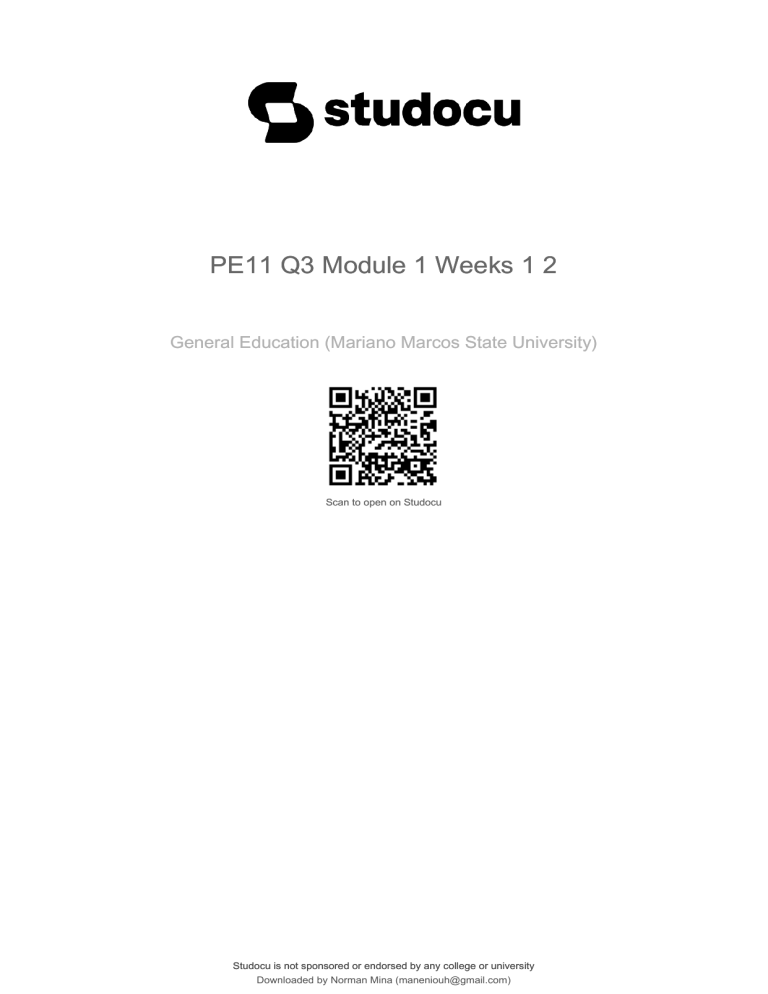
lOMoARcPSD|18501211 PE11 Q3 Module 1 Weeks 1 2 General Education (Mariano Marcos State University) Scan to open on Studocu Studocu is not sponsored or endorsed by any college or university Downloaded by Norman Mina (maneniouh@gmail.com) lOMoARcPSD|18501211 11 11 SENIOR HIGH SCHOOL Physical Education and Health 2 Quarter 3 – Module 3a (Weeks 1-2) Stress Management NegOr_Q3_PEH11_Module3a_v2 Downloaded by Norman Mina (maneniouh@gmail.com) lOMoARcPSD|18501211 Physical Education and Health 2– Grade 11 Alternative Delivery Mode Quarter 3 – Module 3a: Stress Management Second Edition, 2021 Republic Act 8293, section 176 states that: No copyright shall subsist in any work of the Government of the Philippines. However, prior approval of the government agency or office wherein the work is created shall be necessary for exploitation of such work for profit. Such agency or office may, among other things, impose as a condition the payment of royalties. Borrowed materials (i.e., songs, stories, poems, pictures, photos, brand names, trademarks, etc.) included in this module are owned by their respective copyright holders. Every effort has been exerted to locate and seek permission to use these materials from their respective copyright owners. The publisher and authors do not represent nor claim ownership over them. Published by the Department of Education Secretary: Leonor Magtolis Briones Undersecretary: Diosdado M. San Antonio Development Team of the Module Writer: Myra A. Umbac Editors: Jonilo G. Jainar, Jaymar R. Kinkito, Sheena Grace B. Alabata, Maria Teresa S. Bernal Reviewer: Jaymar R. Kinkito, Celene June Brendan J. Dumagan Illustrator: Jaymar R. Kinkito Layout Artist: Management Team: Senen Priscillo P. Paulin, CESO V Rosela R. Abiera Joelyza M. Arcilla, EdD. Maricel S. Rasid Marcelo K. Palispis, EdD. Elmar L. Cabrera Nilita L. Ragay, EdD. Dan P. Alar, EdD. Jenith C. Cabajon Printed in the Philippines by ________________________ Department of Education –Region VII Schools Division of Negros Oriental Office Address: Tele #: E-mail Address: Kagawasan Ave., Daro, Dumaguete City, Negros Oriental (035) 225 2376 / 541 1117 negros.oriental@deped.gov.ph Downloaded by Norman Mina (maneniouh@gmail.com) lOMoARcPSD|18501211 Introductory Message This Self-Learning Module (SLM) is prepared so that you, our dear learners, can continue your studies and learn while at home. Activities, questions, directions, exercises, and discussions are carefully stated for you to understand each lesson. Each SLM is composed of different parts. Each part shall guide you step-by-step as you discover and understand the lesson prepared for you. Pre-tests are provided to measure your prior knowledge on lessons in each SLM. This will tell you if you need to proceed on completing this module or if you need to ask your facilitator or your teacher’s assistance for better understanding of the lesson. At the end of each module, you need to answer the post-test to self-check your learning. Answer keys are provided for each activity and test. We trust that you will be honest in using these. In addition to the material in the main text, Notes to the Teacher are also provided to our facilitators and parents for strategies and reminders on how they can best help you on your home-based learning. Please use this module with care. Do not put unnecessary marks on any part of this SLM. Use a separate sheet of paper in answering the exercises and tests. And read the instructions carefully before performing each task. If you have any questions in using this SLM or any difficulty in answering the tasks in this module, do not hesitate to consult your teacher or facilitator. Thank you. Downloaded by Norman Mina (maneniouh@gmail.com) lOMoARcPSD|18501211 Stress is a reaction of the body and mind to any unpleasant or challenging events in life that requires attention or action. It is a kind of reaction or change that causes physical, emotional, or psychological strain. Some responses like being irritated, frightened or anxious can cause headache or stomachache. Most people consider stress as a negative experience. But in reality, it can also be positive experience. Everyone experiences some degree of stress in their lifetime, it is how we respond to stress makes a big difference to our overall well-being. The positive response of stress to our well-being is called “Eustress” while the harmful consequence of stress is called “Distress”. Eustress or positive stress stimulates you to go on thus you grow and improve. Who would not want to grow and improve? On the other hand, Distress or the negative stress often causes poor performance and even real physical diseases like cancer, immune disorder, etc. The perception of stress as positive or negative response varies from person to person. One single event might result to a positive response to someone while it could be negative response to another person. What I Know PRE-ASSESSMENT Direction: Write TRUE if the given statement is correct; otherwise, write FALSE if it is incorrect. _______ 1. A reaction of the body and mind to unkind or challenging life incidents such as tense feelings, worry and discomfort is called stress. _______ 2. A stressor is an event that causes stress. _______ 3. When threatened by environmental dangers, or demands, a human being experiences a variety of physiological and psychological changes. _______ 4. Stress results when the demands of the environment are lesser than the individual’s perceived coping resources. _______ 5. What serves as a stressor for one person is also the same with another person. _______ 6. Signs of stress should be managed early. _______ 7. Experiencing long term stress is not harmful to you. _______ 8. You can control your level of stress. _______ 9. All stressful events are negative ones _______ 10. Relaxation helps you manage stress. 1 NegOr_Q3_PEH11_Module3a_v2 Downloaded by Norman Mina (maneniouh@gmail.com) lOMoARcPSD|18501211 What’s In What is Stress? “The word “stress” is a commonly used term in today’s vernacular, and most people appear to have an intuitive sense of what it means. Stress is difficult to precisely define as it is often used interchangeably with a variety of other terms, such as anxiety, pressure, or strain (Broman-Fulks, 2015). Stress refers to a collection of physiological, emotional, behavioral, and cognitive reactions that occur in response to environmental demands. As we interact with the world around us, we must make observations of environmental threats, challenges, and demands and attempt to cope with any issues that may come up. At times, environmental demands are easily handled, such as when you have to press a button on a key to unlock your car. However, at other times, the demands of the environment can seem unmanageable, such as when you have to take https://www.psychologytoday.com/ca/ three exams on the same day, and result in feelings blog/coaching-and-parenting-youngathletes/201407/are-youth-sports-tooof physical tension, negative thought patterns, and stressful unpleasant emotional experiences (Sherrod,2019). A “stressor” is any event or stimulus that causes stress. However, what serves as a stressor for one person may not be the same for another. For example, being asked to attend a social event may create stress for someone who perceives that they lack the necessary social skills to fit in, whereas another person who feels comfortable in social situations may not experience any stress. Stressors can take many forms, ranging from the daily hassles of life to significant life changes (Sherrod, 2019). Body Responses to Stress When threatened by environmental dangers, changes, or demands, humans experience a variety of physiological and psychological changes. Once a threat has been recognized and appraised as dangerous, the individual evaluates available coping resources. If the demands of the situation are deemed to be greater than the available coping resources, an “alarm” or “fightor-flight Response” is generated. During the fight-or-flight response, the body prepares for action, generally consisting of either confrontation or avoidance of the threat. The sympathetic nervous system is activated, and hormones, including adrenaline and noradrenaline, are released into the blood stream. Heart and respiration rates accelerate, and blood pressure increases, enabling the https://believeperform.com/anxiety-in-sportsbody to quickly circulate oxygen-rich blood to performance/ the brain and large muscles of the body. Blood is redirected away from the extremities to the core, and digestive processes are 2 NegOr_Q3_PEH11_Module3a_v2 Downloaded by Norman Mina (maneniouh@gmail.com) lOMoARcPSD|18501211 slowed. Muscles tend to become tense, eyes dilate, and hearing becomes more acute. Sweat glands activate to cool the body, and the skin often becomes paler or flushed (Sherrod, 2019). https://quizlet.com/340717421/wellness-literacy-module-6-flash-cards/ If the person is able to successfully manage or avoid the stressor, the body begins to return to homeostasis. However, chronic exposure to stress or recurrent confrontations with stressful stimuli can have a negative consequences on the individual. PHYSICAL SIGNS EMOTIONAL SIGNS BEHAVIORAL SIGNS PSYCHOLOGICAL SIGNS • Muscle tension • Headache • Pounding Heart • Shortness of breath • Increase sweating • Dry mouth • Skin rash • Grinding teeth, nail biting • Anger, Irritability • Impatience • Nervousness • Forgetfulness • Inability to concentrate • Negative thinking • Excessive worrying • Loss of interest • Self-criticism • Frequent crying • Loss of appetite • Overeating • Drug abuse • Sleep problems • Restlessness • Hurrying and talking too fast • Criticizing others • Reckless behavior • Fidgeting • Constantly irritable with other people • Feeling of being a failure • Difficulty in making decision • Loss of interest in other people • Having a hard time to concentrate Task 1: List down five different stressful situations that caused you concern, anxiety or distress and explain how you handled each situation . Write answers in your notebook. Stressful Situation How I handled it 1. 2. 3. 4. 5. Task 2: Answer the following questions below. Write answers in your notebook. 1. From the situations listed in Task 1, what situation in your life were you most stressed? _____________________________________________________________ _____________________________________________________________ _____________________________________________________________ 3 NegOr_Q3_PEH11_Module3a_v2 Downloaded by Norman Mina (maneniouh@gmail.com) lOMoARcPSD|18501211 2. Based on your answer in no. 1, identify the signs of stress you have experienced for each category: a. Physical stress ______________________________________________________________ ______________________________________________________________ b. Emotional stress ______________________________________________________________ ______________________________________________________________ c. Behavioral stress ______________________________________________________________ ______________________________________________________________ d. Psychosocial stress ______________________________________________________________ ______________________________________________________________ 3. What coping strategies did you do? Explain your answer. ______________________________________________________________ ______________________________________________________________ ______________________________________________________________ What’s New Benefits and Costs of Stress Although we generally think of stress as something to avoid, stress is a natural, adaptive response that serves a protective function. At moderate levels, stress helps alert us to potential threats in the environment and enables us to focus our attention on resolving the threat (Sherrod, 2019). https://www.stress.org/the-good-stress-how-eustresshelps-you-grow Although some stress is beneficial, prolonged, or intense stress can be associated with a variety of negative physical and psychological outcomes. For example, moderate amounts of stress help to focus our attention, while excessive stress leads to diminished attention, concentration, decision-making, and shortterm memory. High stress can also lead to a variety of emotional disturbances, including irritability, depression, and anxiety disorders. Indeed, many researchers consider stress a core component of the cause of emotional disorders. Chronic high stress is associated with serious physical health concerns, including cardiovascular disease, https://www.abc.net.au/news/2013-01-11/cibulkovahypertension, immunosuppression and more shows-her-distress/4461900?nw=0 frequent illnesses, sexual dysfunction, gastrointestinal disorders, and recurrent headaches. 4 NegOr_Q3_PEH11_Module3a_v2 Downloaded by Norman Mina (maneniouh@gmail.com) lOMoARcPSD|18501211 It is important to recognize that exceptionally low levels of stress can have negative consequences as well. For example, when arousal levels are too low, people generally experience boredom, poorer cognitive and physical performance, procrastination, and lack of attention to detail (Sherrod, 2019). Stress Management The goal of stress management is not to eliminate all stress. Rather, stress management techniques are designed to keep stress levels within an optimal range. Engaging in healthy lifestyle behaviors can help to reduce stress and maximize the likelihood of living a long, healthy life. The following stress management techniques have been consistently supported by empirical research: ➢ ➢ ➢ ➢ ➢ ➢ physical activity and exercise; healthy eating; adequate sleep; relaxation, mindfulness and meditation; laughter, self-expression and social support; cognitive restructuring https://quizlet.com/340717421/wellness-literacy-module-6-flash-cards/ A Prescription for Stress Management Try the following to maximize your ability to cope with stress: 1. 2. 3. 4. 5. Exercise Regularly Eat a Healthy Diet Sleep Practice Relaxation Express Yourself 6. Reframe What I Have Learned Complete the following: ________________ ______. I have learned that ________________ _________________ _____. I have realized that ________________ _________________ _______________. I will apply _____________ 5 NegOr_Q3_PEH11_Module3a_v2 Downloaded by Norman Mina (maneniouh@gmail.com) lOMoARcPSD|18501211 What I Can Do Task 3: Choose one activity or option below. Option 1: Directions: Create a poster about “Stress Management” and explain what your poster means. Be guided with the criteria below. Write your answers in your notebook. 5 Excellent The use of 5-color combination or more with a remarkable result of creativity. Output is exceptionally unique with much attention to details. 4 Good The use of at least 3color combination with an acceptable work of creativity Output is fair with less attention to details. Effort Work shows extra effort exerted to make the output extraordinary Work shows basic effort exerted to make the output. Punctuality The student submitted the output on time. The student submitted the output a few weeks after the submission period. Rubrics Color and creativity Craftsmanship 3 Poor The use of one-color activity with poor creativity Output is poorly made with no attention to details at all. Work shows little to less effort exerted to make the output. The student submitted as a “removal”. Option 2: Create a video on Simple Exercises to Fight Stress Criteria Excellent 5 pts. Very Good 4 pts. Good Fair Poor 3 pts. 2 pts. 1pt. 1. Content Video is engaging and demonstrates a clear understanding of the topic. 2. Use of Media Displays creativity in making their video content. 3. Clarity of message Displays highly reflective qualities and conveys message that can be understood easily. 4. Punctuality Output is submitted on/before deadline TOTAL 6 NegOr_Q3_PEH11_Module3a_v2 Downloaded by Norman Mina (maneniouh@gmail.com) lOMoARcPSD|18501211 Assessment Direction: Read each item carefully and write your answers in your notebook. A. Write T if the statement is true and F if it is false. ______1. When threatened by environmental dangers, or demands, a human being experiences a variety of physiological and psychological changes. ______2. What serves as a stressor for one person is also the same with another person. ______3. A stressor is an event that causes stress. ______4. Stress results when the demands of the environment are lesser than the individual’s perceived coping resources. ______5. A reaction of the body and mind to unkind or challenging life incidents such as tense feelings, worry and discomfort is called stress. B. Enumeration 1. Stress Management Techniques ______________________________________________ ______________________________________________ ______________________________________________ ______________________________________________ 2. Prescription for Stress Management ______________________________________________ ______________________________________________ ______________________________________________ ______________________________________________ Additional Activity Direction: Look for a saying or a quote that inspires you on how to overcome stress. You may copy or print and paste it in your activity notebook. Note: This activity is optional. Please refer to your weekly home learning plan or seek guidance from your subject teacher. 7 NegOr_Q3_PEH11_Module3a_v2 Downloaded by Norman Mina (maneniouh@gmail.com) lOMoARcPSD|18501211 Answer Key • • • • • • exercise regularly eat a healthy diet sleep practice relaxation express yourself reframe 10. true 9. false 8. true 7. false 2. • • • • • • physical activity and exercise healthy eating adequate sleep relaxation, mindfulness, and meditation laughter, self-expression, and social support cognitive restructuring 6. true 5. FALSE 4. FALSE 3. TRUE 2. TRUE 1. 1. TRUE B. WHAT I KNOW 5. T 4. F answers may vary : TASK 4 3. T 2. F answers may vary: TASK 3 1. T answers may vary: TASK 2 A. answers may vary: TASK 1 ASSESSMENT References Bernstein, D. A., Carlson, C. R., & Schmidt, J. E. (2007). Progressive relaxation: Abbreviated methods. In P. M. Lehrer, R. L. Woolfolk, & W. E. Sime (Eds.), Principles and practice of stress management (3rd ed. Pp. 88-122. New York: The Guilford Press. Chu, L.-C. (2010). The Benefi ts of Meditation Vis-à-Vis Emotional Intelligence, Perceived Stress and Negative Mental Health. Stress and Health, 169-180. Paul, G., Elam, B., & Verhulst, S. J. (2007). A Longitudinal Study of Students’ Perceptions of Using Deep Breathing Mediation to Reduce Testing Stress. Teaching and Learning in Medicine, 287-292. Szabo, A. (2003). The acute effects of humor and exercise on mood and anxiety. Journal of Leisure Research, 152-162. Segrin, C., & Passalacqua, S. A. (2010). Functions of Loneliness, Social Support, Health Behaviors, and Stress in Association with Poor Health. Health Communication, 312-322. https://www.psychologytoday.com/ca/blog/coaching-and-parenting-young-athletes/201407/are-youth-sports-toostressful, accessed December 14, 2021. https://believeperform.com/anxiety-in-sports-performance/, accessed December 14, 2021. https://www.stress.org/the-good-stress-how-eustress-helps-you-grow, accessed December 14, 2021. https://www.abc.net.au/news/2013-01-11/cibulkova-shows-her-distress/4461900?nw=0, accessed December 14, 2021. https://quizlet.com/340717421/wellness-literacy-module-6-flash-cards/, accessed December 14, 2021. 8 NegOr_Q3_PEH11_Module3a_v2 Downloaded by Norman Mina (maneniouh@gmail.com) lOMoARcPSD|18501211 For inquiries or feedback, please write or call: Department of Education – Schools Division of Negros Oriental Kagawasan Avenue, Daro, Dumaguete City, Negros Oriental Tel #: (035) 225 2376 / 541 1117 Email Address: negros.oriental@deped.gov.ph Website: lrmds.depednodis.net 9 NegOr_Q3_PEH11_Module3a_v2 Downloaded by Norman Mina (maneniouh@gmail.com)






